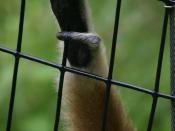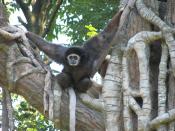The white handed gibbon is the smallest and most arboreal ape in the family Hylobatidae or "dwellers of the trees". Adult gibbons are only about 3 feet tall standing upright and 13 pounds in weight. They are nearly twice as heavy, have longer arms, and are very slender. The Long bushy hair on their bodies makes them look stockier than they actually are. Unlike all of the other ape species, gibbons have little sexual dimorphism in body size.
The long arms, permanently curved fingers, and light bodies of gibbons and make them excellent brachiators. That is, they move around in trees by swinging under branches with a hand over hand motion. At times, they also walk bipedally, or two footed, on top of branches. However, they are more efficient at brachiation and 90% of their locomotion is because of this. A single swing can transport a gibbon 20 feet in distance.
Gibbons in their mating patterns form nuclear family groups. That is to say, their social communities consist of a single mating pair of adults with their juvenile offspring. They live in well defined territories in the tree tops and rarely go down to the forest floor. Adults regularly defend their territory against others of their species with piercingly loud whooping and hooting vocalizations, much like the indris of Madagascar and the howler monkeys of the New World. These calls are used to announce location, defend territory, and to develop and maintain pair bonds. The adults sometimes joined by juveniles, will sometimes sing duets. Each pair develops its own variation on a theme so the vocalizations also identify individuals. Singing is typically done at dawn because of its purpose as a locator and spacing mechanism for groups. However, it may also be heard at other times of the day.
Gibbons live in small, monogamous families composed of a mated pair and up to four offspring. Less than six percent of all primate species (more than 300) are considered monogamous. Gibbons are one of the few apes where the adult female is the dominant animal in the group. The hierarchy places her female offspring next followed by the male offspring and finally by the adult male. Gibbons are physically independent at about three, mature at about six, and usually leave the family group at about eight, though they may spend up to ten years in their family group.
To discover related mannerisms between human behavior and gibbon behavior, I went to Golden Spoon located in the Aliso Viejo town center. I sat on a bench for approximately thirty minutes and documented the human conduct surrounding me. It was about half past twelve on clear warm day. Many people were out on a lunch break. I noticed children and their mother's going for ice cream since it has been a nice day for some frozen yogurt. I could hear some of the mother's telling their children to stay close to them, and that they did. This signified that mother's were of higher authority and were protecting their young ones, likewise to that of the gibbon infants. Some of the mother's were also feeding their children which showed that they were nurturing them and keeping them healthy. Another important thing I observed was a majority of the people around me had just got out of work and were on a lunch break. This symbolized a need for energy so that when they had to go back to work, they could work just as hard. This is relevant because gibbons eat a lot to maintain the energy it requires to move from tree to tree.
Before I went to the zoo, I thought it was going to be a complete waste of time and that I wasn't going to learn anything. However, watching the white handed gibbon was quite interesting to see. They reacted very calmly to my presence. Unlike any other primate groups, there was hardly any aggression among the gibbon towards me or the people I was around. They are remarkably gentle with one another. Competition seemed quite unnecessary.
One thing that I discovered about the gibbon that seemed very similar to humans was their natural instinct of resting. I noticed that after a certain amount of activity, they would rest for a minute, eat a fig, and go right back to swinging from tree to tree. This is relative to humans because after a certain amount of activity, it is natural for humans to take a break, eat something to re-energize, and go right back to what they were doing. This common trait between the gibbon and human was quite interesting to recognize.
The most surprising characteristic that I experienced at the zoo was Gibbon communication. The way I heard it communicate to others was quite an appeal. Its voice could almost pierce you ears if you got close enough to it. I didn't get to hear any kind of duet because the gibbon I was analyzing did not have a mate with it. Next time I go see a gibbon I am looking forward to hearing a beautiful song from them.
As I watched the white handed gibbon, I noticed that many other zoogoers had the tendency to stare at me and figure out why I had been filming the animal. Some of them asked what I was doing, and I told them about my assignment. Many of them seem interested in the project which made me think that most of them liked primates. Some of them for the most part did not say anything and would briefly look at the ape and continue with their tour of the zoo.
I believe that the more you analyze something, such as primates, the more knowledgeable you become. That is how we learn in society, and adapt to our environment. Going to the zoo and watching a gibbon for an hour made me realize how similar some of their traits are to humans; like the way they communicate, react, eat, move. Although they aren't exactly the same, their natural instincts are related and shown more and more as you observe them.
My overall impression of non-human primates after my field research turned out to be very educational and quite enjoyable. I learned a lot on the behavior of a gibbon and the similarities it has to human behavior. There were a lot more than I thought. Actually, I never thought an animal had so many similar instincts to human beings. The fact that an ape has a genetic code over 98% similar to human beings is quite unbelievable when you look at them. You'll never know how interesting it is to learn about primates until you complete a field project like this one. I would recommend this to anyone that has an interest in learning the similarities and differences between hominoids and their social behavior.


